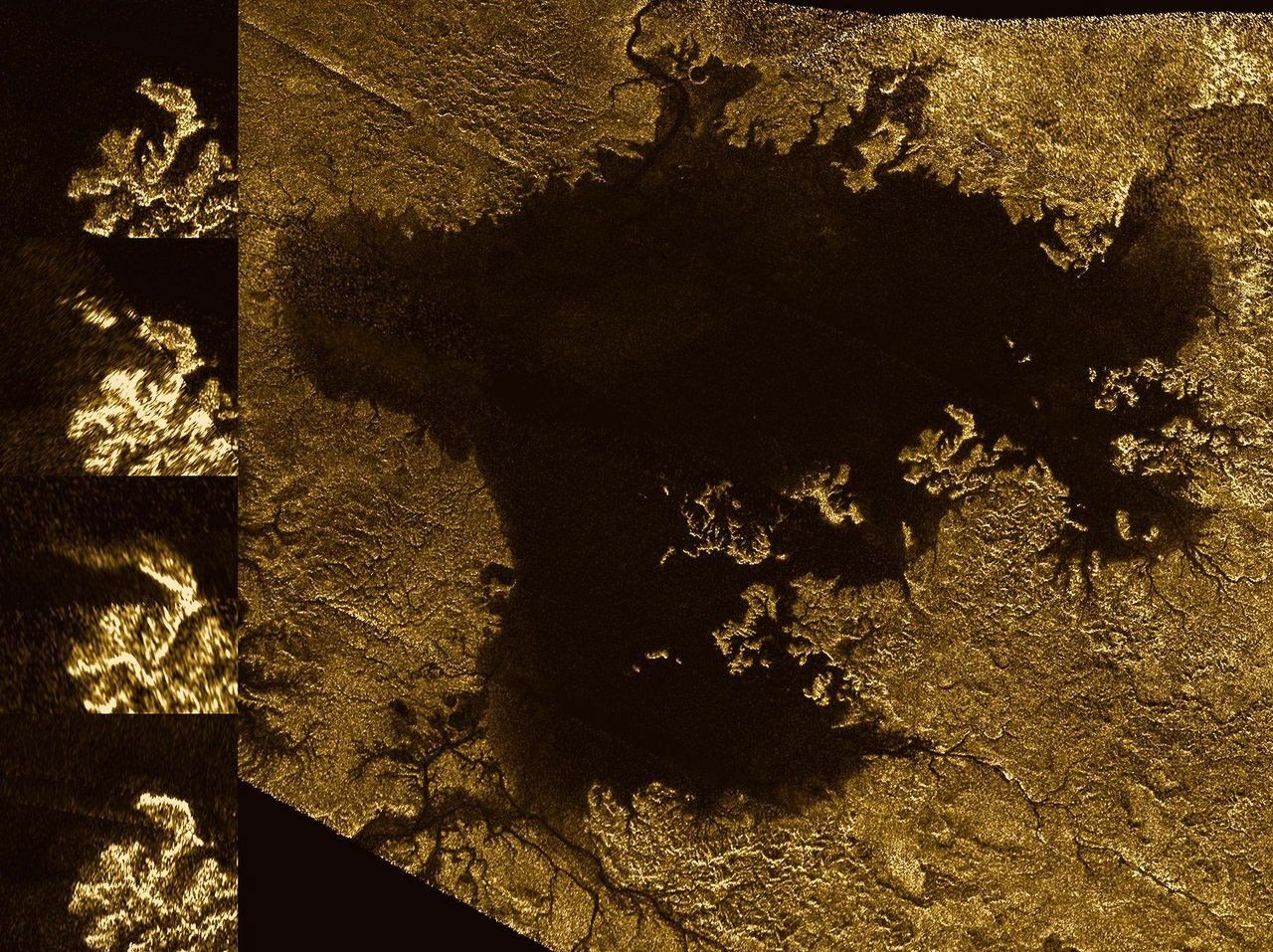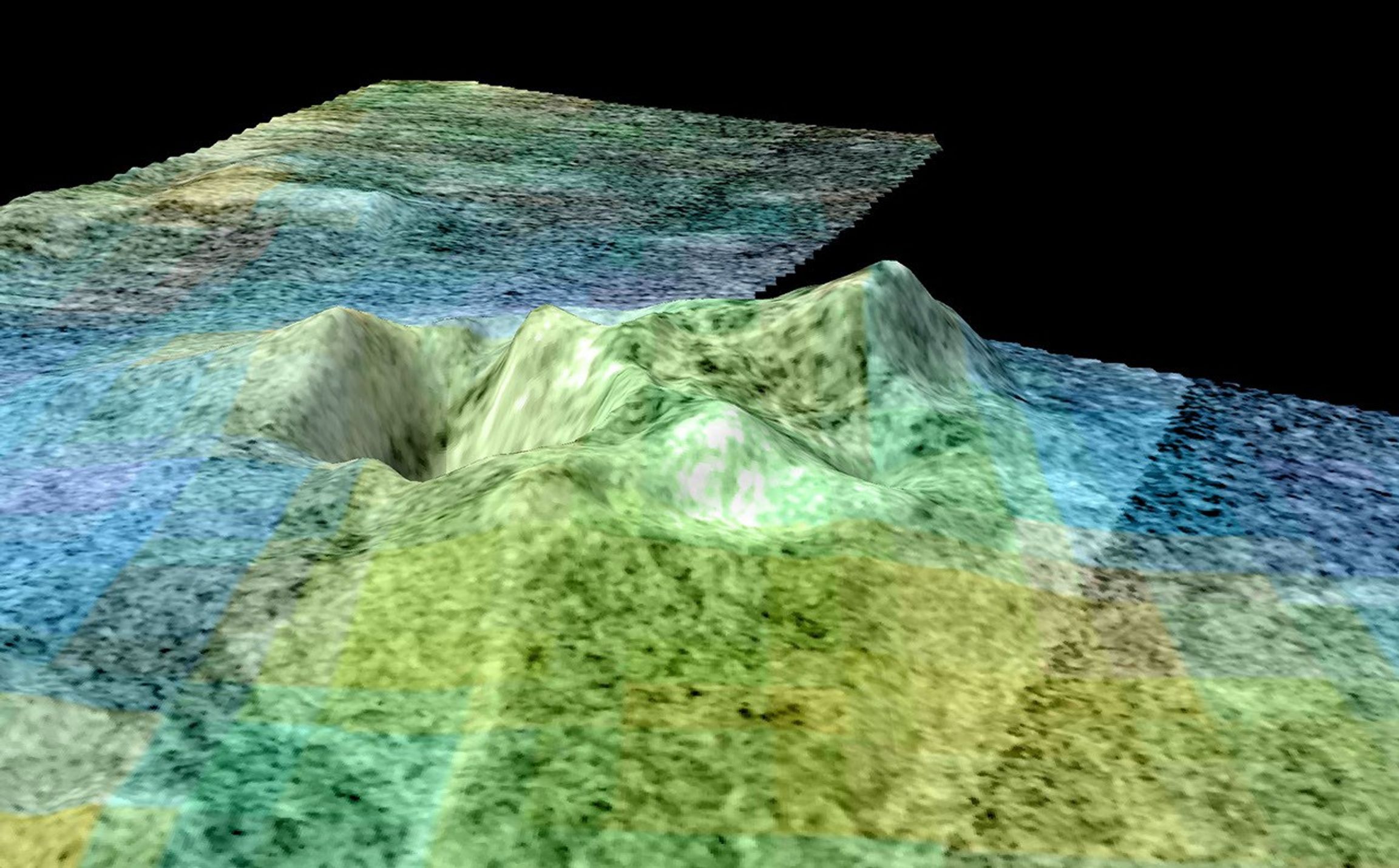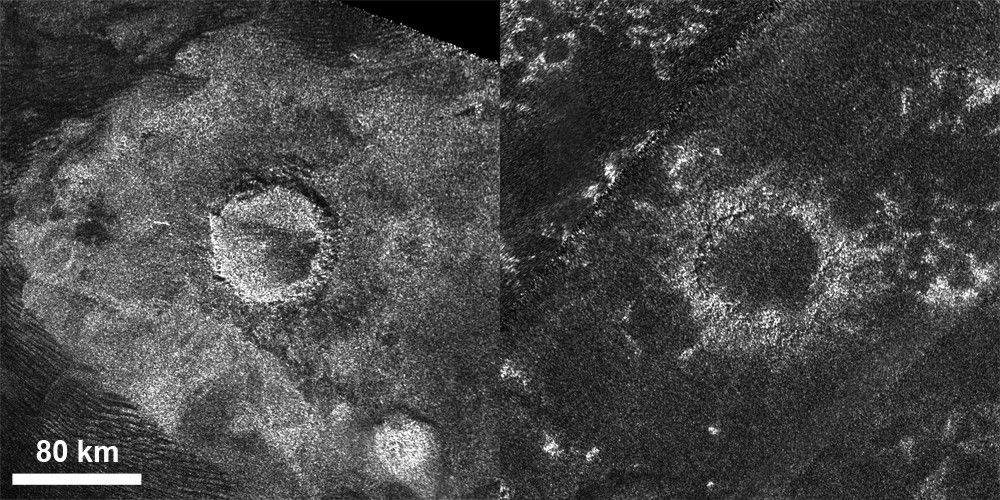Radar
How It Worked
Invisible to human eyes, radio waves can penetrate thick and murky atmospheres, and they bounce off of hard surfaces. Cassini’s radar instrument sent radio waves at surfaces and, by recording slight differences in the signal’s arrival time and wavelength back at the spacecraft, the instrument created pictures of the landscapes upon which it reflected.
How We Used It
Cassini’s radar instrument was built primarily for studying Saturn’s moon Titan, which has a thick atmosphere that hides its surface. The instrument bounced radio waves off of Titan and captured the reflected waves to see what’s below Titan’s haze, such as lakes, mountains, dunes and so on. The instrument detected how smooth or rough surfaces are, making it useful for studying Titan's methane seas. Scientists also used it to study Saturn, its rings, and Saturn’s other moons.
Saturn’s largest moon, Titan, is the second largest natural satellite in the solar system. It is larger than Earth’s moon and even planet Mercury. But before Cassini, no one knew what Titan’s surface looked like. It’s the only moon in the solar system known to have a dense atmosphere, and a global haze hides its surface from view.
A radar is like a flash camera. It carries its own light.- Steve Wall, Cassini Radar Team Member
When the Cassini mission was originally planned, scientists understood that Titan’s haze would hide its surface from most instruments. Radio waves, however, can travel through thick atmospheres, which is why a car radio receives a signal whether it’s sunny, foggy, raining or snowing.
Steve Wall has been helping to design instruments for NASA missions since the mid-1970s and is a scientist at NASA’s Jet Propulsion Laboratory -- as well as acting team leader for the radar instrument. “A radar is like a flash camera,” Wall said. “It carries its own light.”
Instead of visible light, Cassini’s radar emitted radio wavelengths, which bounce off hard surfaces. By measuring exactly how long it took the radio waves to travel from the spacecraft to a surface (and dividing by the speed of light), radar determined the heights and depths of the veiled world’s surface features. Radar data was used to create black and white images in which rough surfaces appear bright and smooth surfaces appear dark.
“Titan was radar’s reason for going, for being on the spacecraft,” Wall said. “It’s actually called the ‘Titan Radar Mapper.’” Wall estimates that 90 to 95 percent of radar’s work since arriving at Saturn was on Titan.
“Before Cassini, using Earth-based radio telescopes, just about all you would see was one bright spot, and you couldn’t see much else because of the atmosphere,” Wall said. However, Cassini reached Saturn orbit in 2004 and performed more than 100 flybys of Titan. Each time the radar got a close look at Titan, it recorded what it saw as it flew by, producing one strip of mapping coverage. Each Titan flyby was a little different from the next, which allowed radar to see different areas of Titan.
The radar instrument helped scientists create the first global topographic map of Titan. “It’s a whole lot more earthlike than we expected,” Wall said.
Titan doesn’t have nearly the number of craters that scientists thought -- maybe just a few dozen. “We’d expect to see more – look at Earth’s moon,” Wall said. Some processes must be steadily changing Titan’s surface to get rid of the craters. “Now we understand, as we did not before Cassini, that (surprisingly) the processes are the same as on Earth. There’s rain, oceans.”
Cassini’s radar provided much of the earliest and most definitive evidence that Titan has standing liquid on its surface in the first couple years of the spacecraft's presence at Saturn. Scientists are now convinced that Titan’s clouds drop methane and ethane rain which flows into streams and rivers and collects in lakes that have been measured at hundreds of miles (kilometers) wide and hundreds of feet (meters) deep. Radar signals even penetrated the lakes’ surfaces. “We can see all the way down to the bottom,” Wall said, “which means the stuff that’s in it is amazingly pure, amazingly clear.”
In addition to flowing liquid, Titan’s surface is also sculpted by wind. “We’ve been able to see a huge field of sand dunes that extends about three-quarters of the way around Titan,” Wall said. Radar data has showed that the dunes, made of hydrocarbon sand, fill in some of Titan’s craters.
Cassini radar scientists also use Earth to study Titan. Wall and other scientists, along with graduate students, visit Earth's deserts, such as the Mojave, to perform comparative geology. The graduate students drag ground-penetrating radar across dunes, and scientists compare data from Cassini’s radar instrument to better understand Titan’s dunes.
Radar can also perform “radiometry,” allowing radar to help determine the temperature of what it observes. “Basically, all we do is turn off the transmitter and listen,” Wall said. It’s like active (versus passive) sonar on a submarine. Sonar can send out a signal and listen for the signal to bounce back, or it can just listen without sending any signal at all. The difference with radar is that it watches for light instead of listening for sound.
Radar also had a third mode called “scatterometry,” which allowed the instrument to see smoothness and roughness at a molecular scale. While a spectrometer can determine what atoms something is made of, radar can determine how atoms are arranged. In other words, graphite and diamonds are both made purely of carbon atoms, yet graphite is soft enough to write on paper, while diamonds are hard enough to drill into rock. Titan’s surface isn't made of graphite or diamonds, but if it were, Cassini's radar could have distinguished between the two. This powerful ability helps scientists explain how surface materials interact on Saturn's hazy moon.
The instrument also provided valuable information about Saturn, its rings and other moons orbiting the ringed planet. But Titan is the place Cassini’s radar was built to see.
At A Glance
RADAR Sensing Instruments:
- Synthetic Aperture Radar Imager [SAR] (13.78 GHz Ku-band; 0.35 to 1.7 km resolution)
- Altimeter (13.78 GHz Ku-band; 24 to 27 km horizontal, 90 to 150 m vertical resolution)
- Radiometer (13.78 GHz passive Ku-band; 7 to 310 km resolution)
RADAR Instrument Characteristics:
- Mass (current best estimate) = 41.43 kg
- Peak Operating Power (current best estimate) = 108.40 W
- Peak Data Rate (current best estimate) = 364.800 kilobits/sec
For more information, see the engineering technical write-up.








































